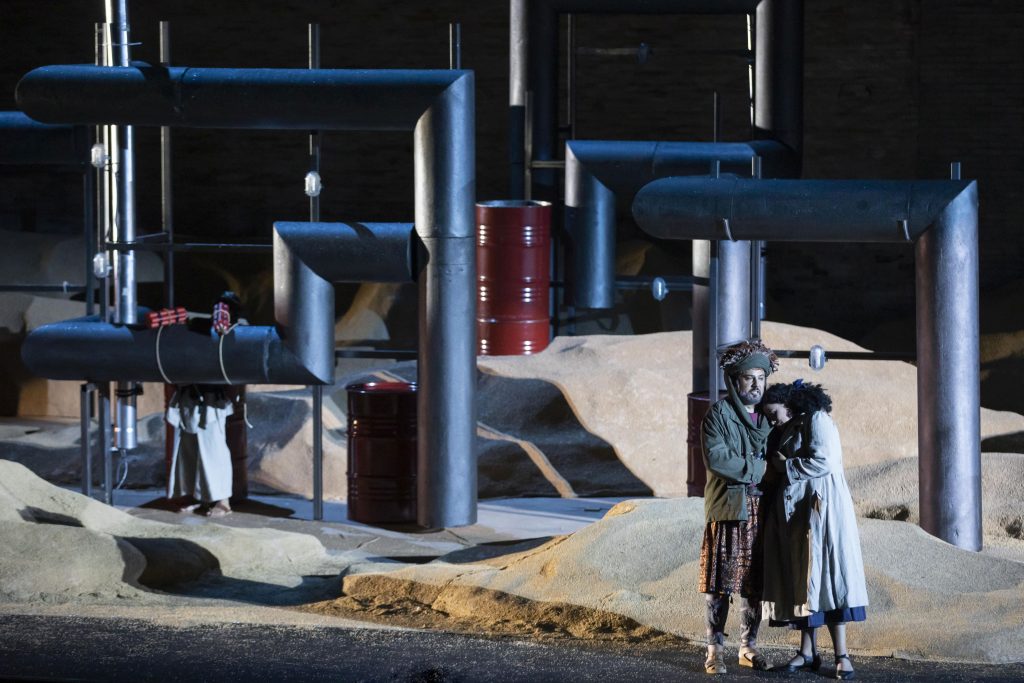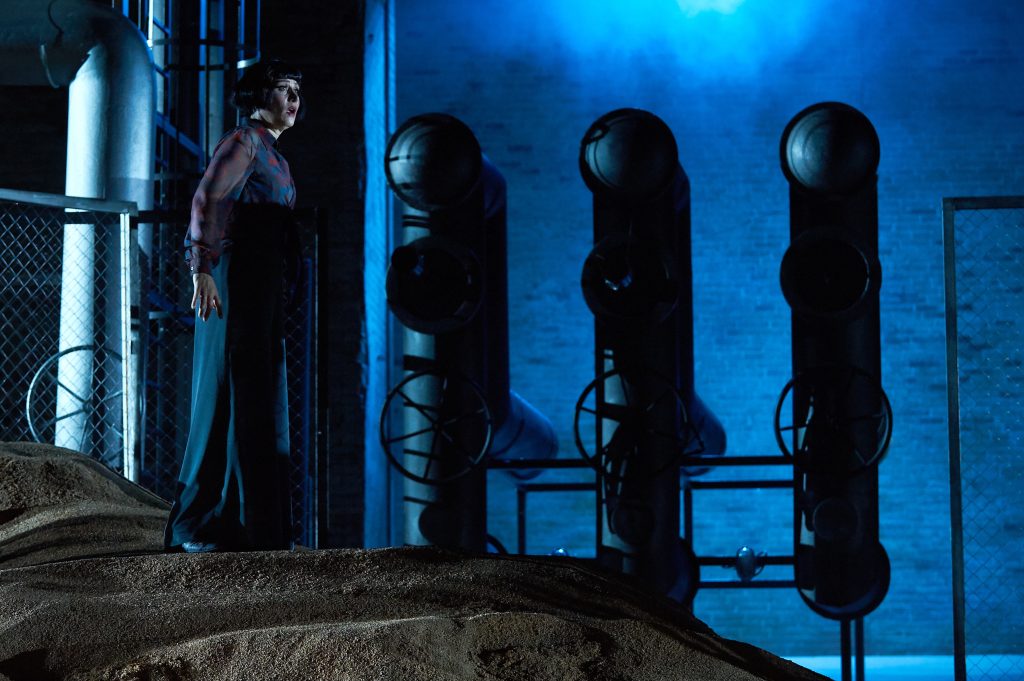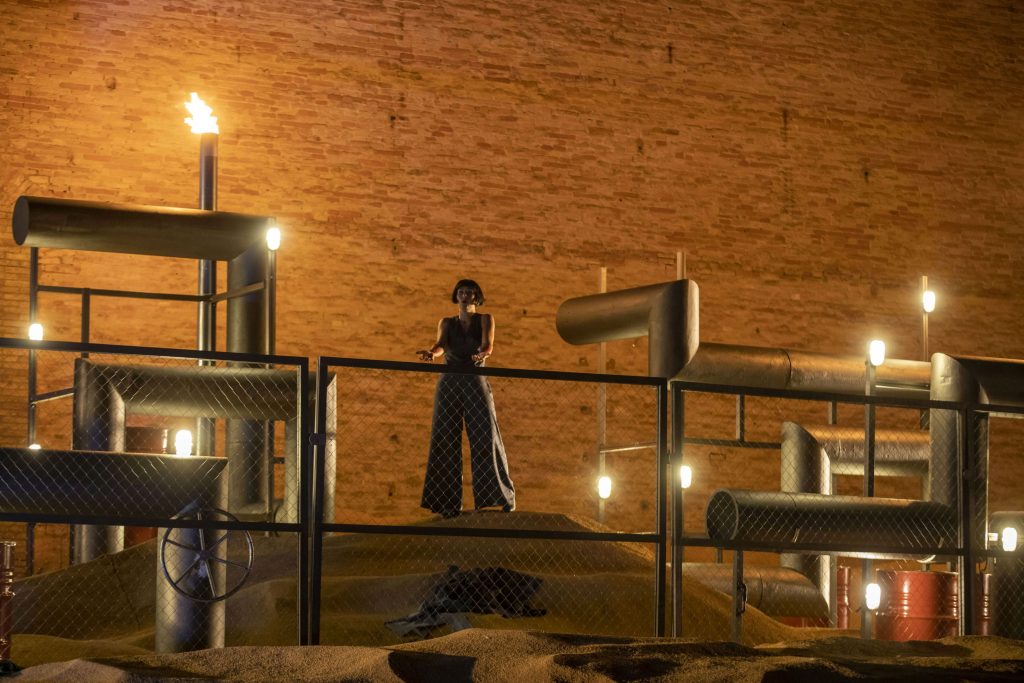ANYTHING-BUT-AIDA IN MACERATA
MACERATA OPERA FESTIVAL 2021.
ATTENDED PERFORMANCE 7 AUGUST 2021.
Aida: Maria Teresa Leva; Il Re: Fabrizio Beggi; Amneris: Veronica Simeoni; Radames: Luciano Ganci; Ramfis: Alessio Cacciamani; Amonasro: Marco Caria; Un messaggero: Francesco Fortes; Una sacerdotessa: Maritina Tampakopoulos; Conductor: Francesco Lanzillotta; Orchestra Filarmonica Marchigiana; Stage ensemble “Banda Salvadei”; Coro lirico marchigiano “Vincenzo Bellini”; Choir Master: Martino Faggiani; Direction: Valentina Carrasco.
Music: ****4****
Direction: *1*
First of all, we owe our readers a warning. There’s a reason why we decided to divide into two parts our comments on the Aida recently staged in Macerata (we saw the live performance on August 7, and then the streaming broadcast on the 12th). Actually, there are several reasons, but there is a main one. It came to us after reading a review in the online magazine Musicultura, which, with its shocking beginning, made us understand perhaps for the first time in no uncertain terms to what extent the death of opera is imminent. The English translation of the first sentence:
“We were pleasantly surprised, because after hearing talk at length about the Aida of 1921, the Aida of the centenary, we expected a historical re-edition with traditional Egyptian costumes, statues of divinities, pyramids, trumpet blasts, processions with flails and camels. Instead, we found ourselves in front of the most innovative and unconventional Aida of recent years and, perhaps for the first time in witnessing this work, we not only ‘participated’ but we actually had fun” (Alberto Pellegrino).
Downright ludicrous
Well, we fear that perhaps we have reached rock bottom: not only do we discover that someone is actually enthusiastic about a show that has absolutely nothing in common with Verdi’s Aïda (except the music, reduced to a mere soundtrack), but the guy is delighted precisely because there is nothing left of Aïda, apart from an empty shell made of wonderful music, filled to the brim with nonsense. Oh, yes, colorful nonsense, sometimes impressive, even surprising, pleasant (at times) to the eye, and even – at least in the opinion of the above reviewer – funny. Or rather, in our opinion, downright ludicrous.
It is the first time in our long life that we meet someone who claims to have had “fun” attending Verdi’s Aïda. Because if you’re looking for something colorful and fun, then you’d be better off at a musical, or better yet a clown show (in truth, some parts of this performance resembled both). But this was Aïda, a masterpiece of human culture, heart, and soul. It is not meant to generate “fun”, but to arouse deep emotion and even a bit of soul-searching.
Bieito was here
But, of course, it all depends on the starting point, on the “concept” of the director, in this case Valentina Carrasco (from Argentina, but the product of the Catalan “cantera” of La Fura dels Baus… and for those who know this group, which is headed by Calixto Bieito, there is no need to add anything else). When – already more resigned than alarmed at the mere mention of Carrasco’s name on the bill – we watched the press conference introducing the opera, we had a very bad feeling about what was in store for us. Actually, on that occasion the director said almost nothing relevant, but went on about some posters she had seen of the Aïda which, a century ago, inaugurated the Sferisterio as an opera house, in particular a Shell advertisement that had made an impression on her. It was from there that the idea of a staging that revolves around oil must have perversely sprouted in her mind – to the point that, far from dying under the “fatal stone”, the protagonists even end up drowning in a pool of crude oil. Among other things, the actual scene is far from effective, consisting only of a blackish liquid pouring over the two singers crouched on the ground (but even seeping into their mouths while singing… can you imagine?) in the most absurd and ridiculous way that anyone could imagine in a serious staging.
Starting from the premise that “her” Aïda had to revolve around the theme of colonialism, the director simply invented a fragmentary story, set in an unidentified desert, in an unspecified time, but for the costumes of Amneris, very elegant, much admired by critics and roughly identifying with the Twenties of the past century.

Radamès on the golf course
Radamès’ profession remains uncertain. At first, he would seem an explorer, or even a tourist, dressed in street clothes, but out of the blue he suddenly becomes a much-decorated general. An obviously clairvoyant critic – since his opinion is not supported by any evidence – even goes so far as to state that he’s a European general in the employ of the Khedivé (actually if he were a mercenary, all his talk about homeland and honor would be worth very little… but why ask coherence from a director?). Anyway, Radamès loves a low-level maid, since Mrs. Carrasco thus sees the role of Aïda alongside Amneris, making her a servant rather than a companion, and thus completely distorting their relationship as is shown in the “true” Aïda (Verdi’s). Aida, complete with an apron, is forced to follow her mistress in the desert, serving her a drink and even carrying her golf bag… because yes, Amneris plays golf in the dunes, one of the many director’s involuntarily comic “inventions” (and, please, tell me why Radamès needs binoculars and a map to stroll in a golf course). Amneris is the daughter of a king who, from his clothing, would seem Middle Eastern, or more likely Turkish, but she seems very Westernized, as does her court, which appears in a sort of desert picnic, at the beginning of the second act, amusing themselves by throwing treats and sausages (!) to the uncivilized natives, who fight to get and eat them directly from the sand.
The opening scene of the opera already says a lot… or even everything. Imagine a Radamès (as we have said, of uncertain origin, but undoubtedly a man of the twentieth century) studying the desert – soon to be a golf course – with his binoculars and map. The fact is that when he meets a kind of priest of an unidentified cult, the first thing he asks him is: “La sacra Iside consultasti?” (Did you consult the sacred Isis?) and you wonder if he is out of his mind. Honestly, we can’t make up our minds whether this scene is more disconcerting or more comical. In fact, it’s actually downright tragic given that we are watching Verdi’s Aïda. Because, of course, for the entire duration of the opera there is practically not a single moment in which the characters don’t say one thing while doing another, giving life to a kind of theater of the absurd.
Absolutely nothing of what happens in Aïda is preserved in Mrs. Carrasco’s schizophrenic “reinvention”, and the viewer is constantly seized by a feeling of “doubling” – or perhaps by the suspicion of having walked into the wrong theater – because he listens to one thing and sees another.

But the actual suspicion, which becomes almost certainty in the face of irrefutable evidence, is that the director, having found her “concept” and invented her story, didn’t even bother to take a look at that old, boring, dusty libretto. This is demonstrated by some of her rash statements in the interview published in the booklet, where, for example, she “discovers the wheel” when, speaking of Amneris and Aida, she states that “in my vision for a moment they even manage to get close as friends“. Yet, if only she had taken the trouble to read the history written by Ghislanzoni and Verdi, she could have spared herself the effort of conjuring up a “vision”.
Libretto – a useless item
But, better still, the director claims that Amneris, “when she begs for peace in the finale, asks for it for the two lovers, but also for herself: it is clear that she will not survive either“. Beyond this “evidence” of the possible death of Amneris (which is not clear at all, but might be a legitimate hypothesis of the director’s, who actually makes her commit suicide by slashing her wrists), what emerges from this sentence is that Ms. Carrasco is not aware – or rather voluntary ignores – that in the “true” Aïda (Verdi’s), Amneris cannot invoke peace for the two lovers, since she doesn’t know that Aïda is in the tomb (i.e. under the oil tap …) and that the two lovers will die together. But, of course, that’s in the libretto, and the libretto is a useless item to her.
Eluding questions
In fact, in the same interview, after she has explained at length the historical-political context of colonialism and its consequences, there is an attempt to bring her back to reality by the precise question of how, in all this, she can respect Aïda‘s plot. But Carrasco is very careful not to answer. Indeed, she eludes the question, completely changing the subject: “It also occurred to me to build a Suez Canal on the scene, but it wasn’t easy to make it spectacular. I thought of an infrastructure that serves to take away treasures, in this case black gold, oil. So, the idea of the oil pipeline seemed fitting to me.” And so, no word is said about her approach to Aïda‘s plot, which clearly doesn’t interest her. What interests Ms. Carrasco – and which, unfortunately, has been appreciated by many – is to put on a “good show” with colorful dances, suggestive lights, some “coup de theatre” (for example, a lot of mummy-like bundles tumbling down the dunes and transforming into dancers wrapped in veils, or the appearance of the monumental pipe constructions during the Triumph scene), regardless of the incongruous… or ridiculous. Like Amneris who, as we have seen, plays golf in the desert or wears a voluminous fox stole more suitable for other climates. Everything is centered on detail, on invention, mostly (one suspects) impromptu, tricks that surprise the audience, rescuing them from the boredom that would undoubtedly (at least, the brilliant directors and critics who praise them seem to think so…) have them firmly in its grip if they were watching the old, trivial, outdated Verdi’s Aïda.

“Modern” directors
We could continue for many pages to talk about this “Not-Aida” point by point, but we believe we have clearly explained the reasons for our concern. The problem is no longer just the ravings of “modern” directors. By now, the main problem is that the audiences, influenced, or rather, plagiarized by far too many “critics,” absurdly succumb to “fashion” and are not only getting used to this kind of distorted nonsense but will soon end up expecting it, or, worse, demanding it.
The emperor is naked
And the music? And the poetry, the feelings, the “soul” of the story as it was written? Will everything end up dumped on the heap of things that have become old and useless?
We don’t have an answer. We don’t know if there is still a way to stem the tide that is dragging us towards this conclusion. But we at least feel the duty to report it. To denounce it.
As in Andersen’s tale, the emperor is definitely naked, though perhaps a naive child, who has nothing to lose and nothing to gain, and so can still stand up and tell the truth.

I don’t see the connection with the French, The British and the Ottoman Empire in Aida..there are two armies here: Egyptians and Ethiopians in war. Are these Egyptians then a symbol of the French, etc? and the poor Ethiopians a victim of colonialistic Egyptians? Aida == ”opera anticolonianista”? Maybe it’s me, history is not my forte. Anyhow, Aida is about love, war, and the suffering of individuals in that situation. Intensely and powerful set in music by Verdi. If the audiences begin to love shows like what you are describing here, yes, sadly, you are right. That could be the… Read more »